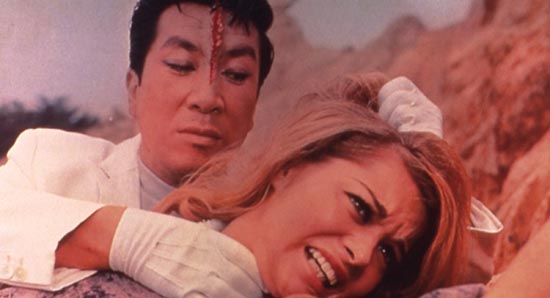SYNOPSIS:
Passengers on a Japanese flight learn of the sighting of a mysterious UFO minutes before an emergency crash landing in an unknown area. After one of the survivors encounters a strange spacecraft and falls under alien control, the others are forced to fight for their own survival.
REVIEW:
A blood-red sky could be a sign of several different things. It might be especially overzealous sunset, a bizarre meteorological phenomenon, or the beginning of a hellish apocalypse.
See if you can guess which option proves true in Goke, Bodysnatcher From Hell.
If you’re looking for a pulpy, schlocky, mildly psychedelic message film nestled into a 1960s Japanese horror/sci-fi romp, then look no further. Directed by Hajime Sato, this 1968 film hits each of those bases with gusto. The practical effects, while low-budget, are creatively executed and still pack a decent punch in terms of the film’s body horror. On the other hand, the film seems decidedly less enthusiastic about investing in any sort of character development and the acting is often painfully hammy.
The first act is set entirely on an airplane – this is where we are introduced to our uniformly one-note cast of characters. A heroic pilot, a flight attendant-slash-damsel-in-distress, a heartless politician, a greedy businessman and his nearly mute wife, a coolly detached psychiatrist, an assassin, and a grieving war widow make up the bulk of our gang of survivors once the plane mysteriously crashes at the end of Act 1.
Prior to the crash landing, we learn that one of the passengers has assassinated the British prime minister, that a mysterious UFO has been spotted entering Japanese airspace, and that there may or may not be a bomb on the place.
Yes, there is a lot going on.
Once the survivors have picked themselves up and dusted themselves off, it is time, as the psychiatrist character says, to “study the reaction of people driven to the limit of their endurance.” What this means for the film is that the characters basically react in the exact ways that we would expect them to. The cutthroat politician tries to sacrifice others and demands obeisance, the businessman looks out only for himself, the pilot works to keep everyone together, and the women are largely without agency.
A hostage situation involving the assassin and a hapless flight attendant leads to an encounter with a glowing flying saucer. The pulsating, glowing spacecraft hypnotizes the assassin and entices him to come inside, where his forehead spontaneously splits open and a gelatinous alien being climbs inside. The assassin thus weaponized, the bodysnatcher spends the rest of the film terrorizing the other survivors (manifesting as a sort of alien vampire in a strange little twist).
This film is strongly anti-war (and anti-violence in general), which is not surprising for a Japanese film made in the 1960s. One of the first conversations in the film concerns the growing gun violence in Japan and the country’s increasing resemblance to the hyper-violent United States (evidently a timeless comparison). The revelation that the politician, Mr. Mano, had promised to broker a sweetheart deal for weapons dealer Tokuyasu is treated as a death knell for the character’s already highly compromised moral standing. The dialogue throughout the film touches on terrorism and the horrors of war, and the carnage in Hiroshima is pointed to as the reason for the targeting of humanity by the alien race hellbent on destroying them. Neal, the grieving widow, is given multiple scenes in which to loudly decry the violence that took her spouse.
The anti-war message, while welcome, is extremely heavy-handed. At times, the film cuts to a blood-red montage of still shots of war and carnage – while thematically relevant, these montages are unnecessary as the narrative already weighs so heavily on its anti-violence message in the second and third acts.
One place where the film thrives is in its trippy, light-drenched depiction of the flying saucer and the practical effects associated with the gelatinous blob that serves the role of the eponymous bodysnatcher. The bodysnatching sequences are exceedingly simple but effective, and the 1960s aesthetic of the ship evokes a charming feeling of nostalgia. This nostalgia is further reinforced by the eerie (and very early sci-fi) music, comprised of strings and strange vibrating hums.
The film may have garnered itself a Criterion release, but perhaps it is better suited for a Mystery Science Theater 3000 type of viewing experience.
Rating: 3 out of 10 gelatinous blobs.
 Horror News | HNN Official Site | Horror Movies,Trailers, Reviews
Horror News | HNN Official Site | Horror Movies,Trailers, Reviews













